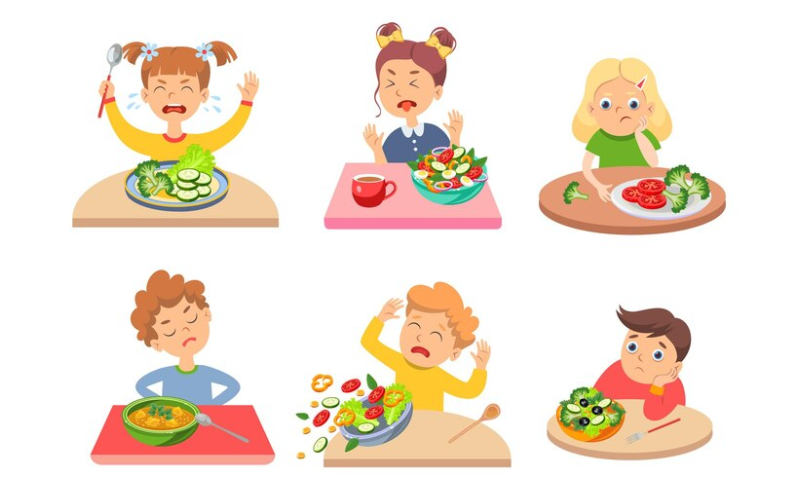
Most Common Food Allergies in Babies :- It’s an exciting and important experience to introduce new meals to your kid. All too frequently, anxiety, doubts and worries regarding food allergies can dampen this incredibly wonderful period. Over the past decade, there has been a sharp rise in the prevalence of food allergies, with some foods seeing a double- or triple-fold increase. In the US today, around 1 in 13 kids suffer from a food allergy. Over 160 foods have been discovered to date, and any item has the potential to produce an allergic reaction.
However, milk, eggs, peanuts, soy, wheat, tree nuts, shellfish, fish and sesame are responsible for 90% of all food allergies and are the most common among children and babies. Dr. Sheetu Singh is a renowned pediatric allergist who possesses extensive expertise in the field of pediatric allergies and immunology. She offers invaluable insights, precise diagnosis, and evidence-based advice for treating food allergies in babies thanks to her extensive knowledge of food allergies and their possible impact on a child’s development.
1. Peanuts
Peanut allergies typically first manifest in a child’s formative years and are a chronic condition. However, up to 22% of kids will discover that their allergy goes away as they get older and enter adolescence. The symptoms of a peanut allergy can range from moderate to severe, and even a small amount of the protein when digested, can trigger serious allergic reactions. When someone with a peanut allergy consumes peanuts or any food that contains peanuts, their immune system interprets the protein as being dangerous. It then overreacts causing symptoms such as itching, stomach aches, swelling and even life-threatening reactions like Anaphylaxis.
2. Tree Nuts
Tree nut allergies are one of the most frequent foods causing acute allergic responses and can be linked to severe allergic reactions like Anaphylaxis, affecting about 2% of the population. If your child has an allergy to one variety of tree nuts, it doesn’t follow that they will also have an allergy to other varieties or even to peanuts. However, there is a high chance that they will be allergic to multiple, closely related types like pecans and walnuts. Even while tree nut allergies typically manifest in childhood and last a lifetime, research suggests that up to 14% of people may eventually overcome their allergies.
3. Milk
Cow’s milk is one of the most common causes of food allergies, especially in young children. Up to 20% of kids may outgrow this allergy by the age of four, while other kids will continue to have it until adulthood. Babies with milk allergies may experience a variety of symptoms, ranging from mild to severe. In contrast to most allergies, a reaction to milk can cause a colicky, unhappy infant, blood in the stool and indicators of stunted growth in addition to more typical allergy symptoms like hives or even anaphylaxis. True milk allergies are distinct from milk intolerance and lactose intolerance. Intolerance doesn’t involve the immune system but rather causes reactions like bloating, indigestion or gas.
4. Egg
About 2% of young children have an egg allergy, which is another fairly frequent food allergy in infants and toddlers. Signs of an egg allergy can include respiratory problems, stomach aches, hives or rashes and in extreme cases, Anaphylaxis. Although egg whites contain the proteins that cause allergies, some kids may only be intolerant to the yolks or the whites and not the other way around. Despite being one of the most widespread allergies, studies have shown that 68% of kids who have an egg allergy will outgrow it by the time they are 16 years old.
5. Shellfish
Shellfish is a term for marine animal species crustaceans, Mollusks and Echinoderms. It includes seafood such as crayfish, lobster, crab, shrimp, clams, oysters, scallops and mussels. Some people who acquire a shellfish allergy may respond to any shellfish, while others may only experience an allergic reaction to one or two. Reactions can range from mild to severe with symptoms like swelling, hives, a stuffy nose and even Anaphylaxis.
6. Fish
Fish allergies, which include typical seafood allergies like Cod and Salmon, can affect up to 2% of the general population. If you or your child has a fish allergy, it does not necessarily follow that you will also have a shellfish allergy and vice versa. A fish allergy can also have similar symptoms as a reaction to viruses, bacteria, toxins or other contaminants in the fish.
7. Grains
Wheat and Oats are some of the most ordinary allergy-inducing grains. A grain allergy develops when your immune system overreacts to proteins found in wheat, as opposed to celiac disease, which is an autoimmune condition that causes a shortage of digestive enzymes for wheat in the intestines. Grains are not only very prominent in food but also in other household products like bath products or cosmetics.
8. Soy
Only 0.4% of babies will acquire a soy allergy, which is brought on by a protein found in soy or items containing soy, and 70% of kids who do will outgrow the allergy as they get older. Normally, allergic reaction symptoms will include swelling and itchiness and only in the rarest of cases can this turn into Anaphylaxis.
